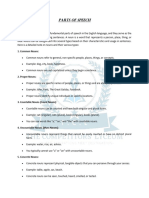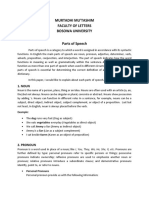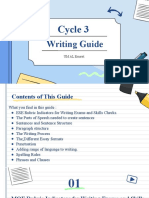Signals of Syntactic Structure
Signals of Syntactic Structure
Uploaded by
John Kelvin RodilCopyright:
Available Formats
Signals of Syntactic Structure
Signals of Syntactic Structure
Uploaded by
John Kelvin RodilOriginal Title
Copyright
Available Formats
Share this document
Did you find this document useful?
Is this content inappropriate?
Copyright:
Available Formats
Signals of Syntactic Structure
Signals of Syntactic Structure
Uploaded by
John Kelvin RodilCopyright:
Available Formats
SIGNALS OF SYNTACTIC STRUCTURE
Function words are words with little or no lexical meaning which are used in combining
other words into larger structures. They serve primarily to clarify relationships between
the more meaning-laden elements of linguistic expression, or to introduce certain
syntactic structures like verbal complements, relative clauses and questions. Function
words tend not to enter freely into the word formation process. They resist affixation and
are seldom compounded with other words to form new ones.
There are eight main groups of function words: the noun determiners,
auxiliaries, conjunctions, quantifiers, prepositions, pronouns, and interjection.
a. Noun determiners are words that come before a noun and serve to modify the noun.
They modify nouns by providing context and specificity to the noun. There are three
types of determiner: the articles, possessives, and demonstratives.
1. articles
- the most popular type of determiner.
- can be divided in definite and indefinite article.
- definite article: the article “the”, refers to a specific person, place, or thing.
Using the word 'the' as a determiner, increases the exactness of the subject in a
sentence.
- indefinite article: “a” and “an”, which means that the noun they precede
isn't an exact person, place or, thing; rather, the article creates a more
generalized noun.
Example: The cat eats the mouse's cheese.
A cat ate the mouse's cheese.
2. possessives
- ours, yours, mine, theirs, hers, and his can be used as determiners.
- a possessive determiner provides context in a sentence because it informs the
reader what belongs to the subject.
Example: Her car is over there.
Prepared by: Anne Joshua O. Bautista Page 1
3. Demonstratives
- Words such as that, this, there, these, and those
- Demonstratives serve as determiners that locate a noun in a specific location.
Example: That guy is a friend of mine.
b. Auxiliaries are “helping” verbs that combine with various parts of other verbs to make
verb phrases.
1. primary auxiliaries
- are the be, have, and do
- be verbs: use to form the continuous tenses and passive voice. (is, are, was,
were)
- have: use to form the perfect tenses
- do: use for questions and negative sentences in the present simple and the past
Simple tenses
2. modals auxiliaries
- include can, could, will, would, shall, should, may, might, must, and ought.
- used to express necessity and possibility.
c. Conjunction is used to link words, phrases, and clauses. The kinds of conjunctions are
coordinating, subordinating, and correlative conjunctions.
1. Coordinating conjunction
- a conjunction that joins two similarly constructed and/or syntactically equal
words or phrases or clauses within a sentence.
- FANBOYS (for, and, nor, but, or, yet, so)
2. Subordinating Conjunction
- A conjunction that introduces a dependent clause.
- If, because, although, since, whenever, wherever, while, that, etc.
Prepared by: Anne Joshua O. Bautista Page 2
3. Correlative Conjunctions
- A paired conjunction that links balanced words, phrases, and clauses.
- The elements connected by correlative conjunctions are usually parallel--that is,
similar in length and grammatical form.
- both . . . and, either . . . or, neither . . . nor, not . . . but, not only . . . but also
d. Prepositions are the words that indicate location. Usually, prepositions show this
location in the physical world. Prepositions can also show location in time.
- on, in, under, beside, above, below, across, up, down, beneath, from, etc.
e. Pronouns are words that substitute a noun. There are several types of pronouns
including:
1. Personal Pronouns
- include I, you, he, she, it, we, the, us,
- replace nouns representing people.
2. Possessive Pronouns
- are used to show possession.
- my, mine, your, yours, his, her, its, their,
3. Relative Pronoun
- use to add more information to sentence
- which, that, who, whom, whose,
4. Demonstrative Pronoun
- are used to demonstrate or indicate
- this, these, that, those
Prepared by: Anne Joshua O. Bautista Page 3
5. Indefinite Pronoun
- used to replace unspecific things.
- the largest group of pronoun
- all, some, any, several, anyone, nobody, each, both, few, either, none, etc.
6. Reciprocal pronoun
- used for actions or feelings that are reciprocated.
- each other, one another
7. Reflexive Pronouns
- refers to another noun or pronoun in the sentence.
- myself, yourself, herself, himself, itself, ourselves, yourselves, themselves
f. Interjection a word added to a sentence to convey emotion. It is not grammatically
related to any other part of the sentence. In writing, an interjection is typically followed
by an exclamation point.
- Ouch!, Oh No!, Hey!, Oh my God!,
g. Quantifiers express a contrast in quantity. It tells us how many or how much.
- few, some, many, little, a lot, none, less, most more, no, enough, etc.
Prosody is the patterns of stress and intonation in a language. In addition, prosody is an
important element of language that contributes toward rhythmic and acoustic effects in a
piece of writing. It includes different elements, such as scansion, sound, pace, and
meaning.
Derivational Contrast is the addition of the prefixes or suffixes that change the world
class.
Example: manage→ manager→ management
lead→ leader→ leadership
Prepared by: Anne Joshua O. Bautista Page 4
You might also like
- Gramm-Voc Booster B2 SSDocument19 pagesGramm-Voc Booster B2 SSVanesa Merino82% (11)
- German How To Learn German Fast - Including GrammarDocument161 pagesGerman How To Learn German Fast - Including GrammarCharlieLevitt88% (25)
- Quechua LessonsDocument8 pagesQuechua Lessonscarlos ArozamenaNo ratings yet
- (Karl C. Sandberg, John R. Wendel) German For Read PDFDocument14 pages(Karl C. Sandberg, John R. Wendel) German For Read PDFweberab1No ratings yet
- Sentence Diagramming Adjectives Adverbs ArticlesDocument2 pagesSentence Diagramming Adjectives Adverbs ArticlesrowenimaryNo ratings yet
- PARTS OF SPEECH UpdatedDocument12 pagesPARTS OF SPEECH UpdatedMCC Gilgit-BaltistanNo ratings yet
- Teaching and Assessment of Grammar Midterm CoverageDocument4 pagesTeaching and Assessment of Grammar Midterm CoverageRoselyn AlbisoNo ratings yet
- Parts of Speech by TadhiDocument8 pagesParts of Speech by TadhiMurtadhi Mu'tashimNo ratings yet
- Notes Part of SpeechDocument11 pagesNotes Part of SpeechNurin Adleena AdamulhaszaNo ratings yet
- Parts of Speec1Document1 pageParts of Speec1jasminespalmadobcc26No ratings yet
- Engpro ReviewerDocument3 pagesEngpro ReviewerPrincess Gabrielle BrotonelNo ratings yet
- Writing GuideDocument86 pagesWriting GuideSedra Mousa Al Samara mousa almokdad Almokdad al samara100% (1)
- Common Transitional Words and PhrasesDocument5 pagesCommon Transitional Words and PhrasesArianne Kate BorromeoNo ratings yet
- Parts of Speech: The A An 'SDocument1 pageParts of Speech: The A An 'SNoemi Galleto GuevarraNo ratings yet
- Module 1Document14 pagesModule 1Estrella RetiroNo ratings yet
- Parts of SpeechDocument4 pagesParts of Speechwwwrehmanbhai3No ratings yet
- Parts of SpeechDocument47 pagesParts of SpeechApril RiceNo ratings yet
- Grammar DefinitionsDocument11 pagesGrammar DefinitionsMaría VielmanNo ratings yet
- Technical Writing 1 Prelim Module For StudentsDocument10 pagesTechnical Writing 1 Prelim Module For StudentsTayaban Van GihNo ratings yet
- Parts of SpeechDocument1 pageParts of SpeechRaquel ESPAD Cangas100% (1)
- Yellow Booklet - Revised 2013 PDFDocument42 pagesYellow Booklet - Revised 2013 PDFBabak EbrahimiNo ratings yet
- E9 Adjective&adverbDocument5 pagesE9 Adjective&adverb29camziiNo ratings yet
- Final Test (Uas) : English MorphologiDocument20 pagesFinal Test (Uas) : English MorphologiKanak SasakNo ratings yet
- Elin103semifinals ReviewerDocument8 pagesElin103semifinals ReviewerNor-ayn PalakasiNo ratings yet
- The 9 Parts of SpeechDocument3 pagesThe 9 Parts of SpeechDana Sofia GrapaNo ratings yet
- Verbs 2.4Document8 pagesVerbs 2.4alylapena09No ratings yet
- Midterm Exam SerranoDocument4 pagesMidterm Exam SerranoNolan G. SerranoNo ratings yet
- Looking For ReferencesDocument24 pagesLooking For ReferencesSorat AbdulsataNo ratings yet
- Engl6 ReviewerDocument3 pagesEngl6 ReviewerFSENGLISHMORTA, ROSE-ANN A.No ratings yet
- Unit 5 SyntaxDocument37 pagesUnit 5 SyntaxNapatNo ratings yet
- Type of WordsDocument3 pagesType of WordsDavid-Emmanuel SilueNo ratings yet
- Linguistic Group 4 Report Syntax 10-16-2024Document103 pagesLinguistic Group 4 Report Syntax 10-16-2024aaron johnNo ratings yet
- Parts of SpeechDocument10 pagesParts of SpeechSaikat SahaNo ratings yet
- Parts of Speech Revised 9-23-21Document7 pagesParts of Speech Revised 9-23-21Khalil MesrarNo ratings yet
- Noun, Verb, Conjuction EtcDocument2 pagesNoun, Verb, Conjuction EtcKhadijah TimiatyNo ratings yet
- Biru Hijau Imut Ceria Tugas Presentasi Kelompok - 20240317 - 230007 - 0000Document24 pagesBiru Hijau Imut Ceria Tugas Presentasi Kelompok - 20240317 - 230007 - 0000saputsaput251No ratings yet
- English SuffixesDocument3 pagesEnglish Suffixeskheisya995No ratings yet
- Parts of SpeechDocument117 pagesParts of Speecholiverosjhend1485No ratings yet
- Parts of Speech The Building Blocks of LanguageDocument10 pagesParts of Speech The Building Blocks of LanguagetausifnaileNo ratings yet
- PRONOUNSDocument12 pagesPRONOUNSAdeleine CantorneNo ratings yet
- Textbook 2Document91 pagesTextbook 2Anh PhanNo ratings yet
- Set 1-Grammar Ii - Part 1Document8 pagesSet 1-Grammar Ii - Part 1Cele AlagastinoNo ratings yet
- Grammar Terms and What They MeanDocument4 pagesGrammar Terms and What They Meanmuslimuser610No ratings yet
- Form-ClassesDocument8 pagesForm-ClassesLộc TrầnNo ratings yet
- MODULE 5 Morphology Lingusitics 1Document11 pagesMODULE 5 Morphology Lingusitics 1yanniesarenomilNo ratings yet
- 8 Parts of SpeechDocument4 pages8 Parts of SpeechTrisha CalmaNo ratings yet
- What Is Noun?Document4 pagesWhat Is Noun?Christian GarciaNo ratings yet
- ELE123 Structure of English LessonsDocument110 pagesELE123 Structure of English LessonsRain Raven Barlizo LabanzaNo ratings yet
- Unit I - Linguistic UnitsDocument17 pagesUnit I - Linguistic UnitsSofia AyalaNo ratings yet
- De Juan - Written Activity No. 1 (English)Document15 pagesDe Juan - Written Activity No. 1 (English)J.L Gaming YTNo ratings yet
- LET English Major LanguageDocument25 pagesLET English Major LanguageSharmaine Llasus FerrarezNo ratings yet
- 1º Año Clase 3 - 13 Abril - Grammar 1Document9 pages1º Año Clase 3 - 13 Abril - Grammar 1Jo O ConnorNo ratings yet
- Chapter 1 & 2Document12 pagesChapter 1 & 2Arc Angelus Civitas SchoolNo ratings yet
- Parts of SpeechDocument10 pagesParts of SpeechtausifnaileNo ratings yet
- 822 - Cir 253 Grade 10 Pcbo Reference MaterialDocument106 pages822 - Cir 253 Grade 10 Pcbo Reference MaterialPRANIT KANDASAMYNo ratings yet
- Virtual Training Handbook I - English Communication Skill TrainingDocument18 pagesVirtual Training Handbook I - English Communication Skill TrainingAlfred Mc Donald Dillupac100% (1)
- Part of SpeechDocument20 pagesPart of SpeechGewie Shane Blanco SumayopNo ratings yet
- Grammar Theory.Document6 pagesGrammar Theory.AndreaNo ratings yet
- Grammar and Punctuation: The Parts of SpeechDocument2 pagesGrammar and Punctuation: The Parts of SpeechjonfoukNo ratings yet
- Eng ProfDocument6 pagesEng Profkoap9166No ratings yet
- IELTS GRAMMAR (From Basic To Types)Document18 pagesIELTS GRAMMAR (From Basic To Types)Builoan1986No ratings yet
- Basic Com. Information Sheet.1.1-1 Part of SpeechDocument5 pagesBasic Com. Information Sheet.1.1-1 Part of SpeechJhoerey D VillegasNo ratings yet
- The Parts of SpeechDocument13 pagesThe Parts of SpeechJoykson HaronisNo ratings yet
- Reporting EL102Document36 pagesReporting EL102Rojane mae BangcoreNo ratings yet
- 7 Days to Grammar Excellence: How to Master English from Beginner to AdvancedFrom Everand7 Days to Grammar Excellence: How to Master English from Beginner to AdvancedNo ratings yet
- b2 First - Presentation & PracticeDocument58 pagesb2 First - Presentation & Practicejysfshj6xpNo ratings yet
- 21-Auxiliary Verbs - Different UsesDocument2 pages21-Auxiliary Verbs - Different UsestakibelNo ratings yet
- Simple Past & PresentDocument6 pagesSimple Past & PresentAidiya Tri Yolanda100% (1)
- The Passive Voice - Structures of Tenses - Grade 8Document1 pageThe Passive Voice - Structures of Tenses - Grade 8Ý ThiênNo ratings yet
- Class-7 English Workbook PDFDocument14 pagesClass-7 English Workbook PDFsarthak kothariNo ratings yet
- Passé Composé - AvoirDocument4 pagesPassé Composé - AvoirAvani KukrejaNo ratings yet
- Degree ExerciseDocument5 pagesDegree Exerciseminuchakraborty1950No ratings yet
- 3 Simple SAT Grammar TipsDocument2 pages3 Simple SAT Grammar TipsMGunNicholasNo ratings yet
- Active Voice Vs Passive VoiceDocument23 pagesActive Voice Vs Passive VoiceZaki BadrNo ratings yet
- Part-Of-Speech Tagging: A Simple But Useful Form of Linguistic AnalysisDocument18 pagesPart-Of-Speech Tagging: A Simple But Useful Form of Linguistic AnalysisDerryzaNo ratings yet
- AdverbsDocument5 pagesAdverbsHarsh ChoudharyNo ratings yet
- Upper Intermediate GrammarDocument13 pagesUpper Intermediate GrammarPedro MarsiNo ratings yet
- Grade Six CompDocument4 pagesGrade Six CompMohamed OmranNo ratings yet
- CHAPTER 8 - The Passive Voice - Grammar IIDocument10 pagesCHAPTER 8 - The Passive Voice - Grammar IIAranza CastilloNo ratings yet
- Lesson 7 1. Present Continuous: Ce Forme Sunt?Document5 pagesLesson 7 1. Present Continuous: Ce Forme Sunt?Andreea VasileNo ratings yet
- Part-1 - YET - Grammar Series - Noun IntroDocument21 pagesPart-1 - YET - Grammar Series - Noun IntroChandra Sekhar PurkaitNo ratings yet
- 6th German GrammarDocument58 pages6th German GrammarDidier SanonNo ratings yet
- Words in The Song LyricsDocument8 pagesWords in The Song LyricsKenichi KanekoNo ratings yet
- Bahan Ajar Talking About SelfDocument5 pagesBahan Ajar Talking About SelfRirin RizkiNo ratings yet
- Compound Adjectives: By: RonaldiDocument13 pagesCompound Adjectives: By: RonaldiRonaldi100% (3)
- Auxiliary (Or Helping) Verbs: Haven't Written All The Letters YetDocument5 pagesAuxiliary (Or Helping) Verbs: Haven't Written All The Letters YetSania RamadhiniNo ratings yet
- 249 Powerful Verbs Jerry Jenkins PDFDocument5 pages249 Powerful Verbs Jerry Jenkins PDFアーシャーワッド セガルNo ratings yet
- The Guide To Understanding and Writing French Texting SlangDocument2 pagesThe Guide To Understanding and Writing French Texting SlangRobert MacaulayNo ratings yet
- Text EAPDocument4 pagesText EAPjesy mrpgNo ratings yet
- UyghurreaderDocument111 pagesUyghurreaderRyan WhymanNo ratings yet

























































































